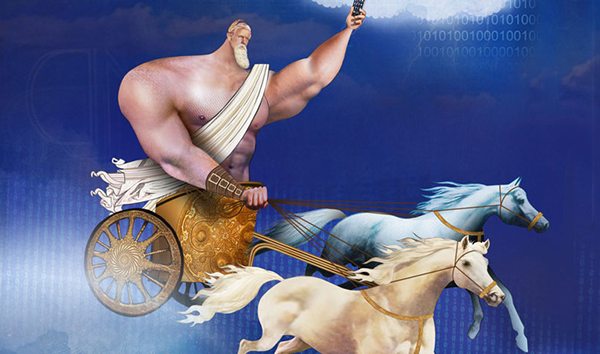A new generation of smartphone-friendly enterprise resource planning (ERP) systems is emerging, and vendors hope they will finally get data off the old IT servers and into the hands of managers.

In today’s data-rich business environment, the insights hidden in a business’s numbers are more valuable than ever. Unless they can be accessed quickly, however, they can only offer management a rear-vision mirror view of what has been happening in the organisation.
Makers of enterprise resource planning (ERP) systems are trying to address this problem with a new generation of tools such as ERP “dashboards”. These can serve up regularly updated reports on a smartphone or iPad and aim to give management clearer vision out of the windscreen and a firmer grip on the wheel.
These dashboards can help overcome thorny and complex data management challenges in all sorts of industries. Take registered clubs, for example. Their duties include organising food, beverages, gaming, functions and membership services, as well as managing their staff. Many clubs’ annual revenues run to millions of dollars, and there are significant compliance issues to navigate.

“Joe” is a New South Wales club CEO who doesn’t want his real name published, because he’s using his ERP to keep an eye on one of his senior staff. “I’ve got figures day on day, week on week – I’ve got a dashboard,” he says.
“I open it up, with the beverage manager sitting in front of me. Let’s look at gross profit on bar since November. It’s been 64 [per cent], 63, 64, 64, 65, 64, 65. What is it this month? It’s 58 – that’s 7 per cent down, and I’ve got that anomaly instantly. He finds A$4500 of stock. Do I think he’s lifting? No, but he’s got to know I’m watching closely.”
Everyone in business is watching closely, and the insights they need are most likely somewhere in the ERP.
“ERP is generally the largest, most complex and most expensive software investment, as well as being a fundamental backbone to business operations,” claims technology analysis firm Gartner.
In decades past, ERP vendors such as SAP and Oracle created huge monolithic platforms intended to hold all the transaction data required by finance, HR, purchasing, manufacturing and distribution to run a business. Local ERP vendors also emerged in Australia and New Zealand – the likes of Adept, Greentree, Pronto and TechnologyOne. In those years, ERP systems became infamous for the high costs and long delays often involved in installing them. More recently, with these costly and complex systems largely in place, many of them sat whirring along in the IT department without delivering much direct insight to management.
Dashboards and mobiles
Two technologies hold the promise of changing this picture: dashboards designed to bring to the surface the most important information; and mobile phones and tablets, which allow access from anywhere. These are the tools that club manager Joe has been using to keep an eye on his bar profits.
Oracle’s ERP general manager Thomas Fikentscher says Australian enterprise is at the 80:20 point now: while 80 per cent of organisations rely on manual intervention to get insights out of their ERP, the 20 per cent who are early adopters are embracing dashboards and mobile devices to get instant insights.
Graham Hill, director of ERP vendor Greentree International, agrees that most systems now hold untapped data. He says the value in lifting data out of ERPs and serving it through dashboards is that it can be finely tailored. One business might want to know about stock churn; others will focus on job costs, top salespeople or which regions are performing best. Business intelligence tools linked to the ERP data, meanwhile, let managers perform what-if analyses, such as “what happens to profits if we lift the retail price [of an item] by A$5?”
Drawing in data
Today’s systems are also getting better at adding data from outside sources. The problem with old ERPs was that companies often had to shoehorn their processes into what the computer system would allow. That’s no longer an option for innovating businesses – there has to be flexibility, and to get that, the ERP is increasingly a hybrid solution woven from different vendors’ systems.
For instance, agricultural businesses might want to integrate information from the ERP with long-term weather forecasts. With the right integration tools and open application programming interfaces (APIs), pretty much anything is possible.
“The new approach is to build an ERP dashboard, make it available on a smartphone or ipad, then serve up key reports filled regularly with fresh data.”
Gartner research director Denise Ganly says today’s ERP “is less about transactions and more about analytics and information”. The rise of hybrids, or what Gartner calls “postmodern ERP”, means that data may be drawn from multiple systems supplied by a raft of different vendors, some in the cloud and some in-house.
Gartner estimates that 77 per cent of organisations currently have a hybrid environment. The price of agility and flexibility is that compared to single vendor monolithic ERPs, these postmodern environments can be more challenging to install and manage. The payoff is additional agility and flexibility.
Today, says Ganly, ERP is whatever an organisation uses to run its operations, and it’s vendor-agnostic. She says that every time she sees a new client, she asks them what they mean by ERP, and every time she gets a different answer, concluding “ERP is whatever your organisation deems it to be”.
Ganly adds that the notion that monolithic ERPs of yore ever provided a “single source of truth” is overblown in any case – there was always something that wasn’t in there.
“Say there was a big tax change coming that would impact amortisation – it’s not reflected in your systems; it’s just something you know,” she says.
Need to know
Demand for instant insight from ERPs is such that Capgemini vice-president Frank Windoloski says that when his firm finishes its large ERP projects, “within a few days we get questions from executives – ‘where’s my data?’”.
He says users expect more and more information to be instantly available, and that is prompting a shift in the way systems are being designed.
An energy utility with more than A$1 billion in revenues has, for example, developed its data analytics platforms first. “After it’s worked out the master data it needs, it will work out the ERP,” says Windoloski. He thinks this is a signpost to the future, “rather than an 18-month ERP program, and then wondering what to do with the data”.
The changing approach to data also allows companies to leverage sources such as social media, weather, location systems – even internet-connected sensors – rather than just relying on what’s stored in the ERP.
Oracle’s Fikentscher says leveraging cloud-based systems can accelerate the process and deliver far more data transparency, greater business insights and the opportunity to use exception-based handling to send amber and red alerts when predefined tolerances are approached or breached – such as when club manager Joe’s gross profit on bar is suddenly A$4500 out of kilter.
“Early adopters are embracing ERP dashboards and mobile devices to get instant insights.” Thomas Fikentscher, Oracle
Speed of access
SAP HANA, a database management system, allows near real-time access to data. ERP runs that once took four days can now take just 40 minutes.
Run speed is nice, but what matters most is the speed at which the system gets that data to where it’s useful.
Earlier this year, developer SAP SE and Apple announced a software developer’s kit that lets organisations build native applications for the iPhone and iPad, drawing in data from SAP HANA but using Apple features such as Touch ID, Location Services and Notifications.
SAP Fiori, launched in 2013, already supported HTML5, so SAP ERP data could be displayed on any mobile device.
The Apple deal gives access to native functions on Apple’s handheld devices. SAP apps, such as RealSpend and Payment Approvals, also allow reports to be built on the fly from ERP data on an iPad or push payments data to managers’ iPhones for instant approval in order to speed workflow.
By getting at enterprise data faster and from anywhere, users can take meaningful action faster. The challenge now is that “much wants more”. Carl Harris, SAP SE’s analytics sales director, says there is an increasing demand not just for executive access to information, but for consumer access to the same information. This, for example, would let customers order items that the ERP says are in stock.
In this case, it’s not the IT department that knows what information to serve up; it’s the business. Harris says leading-edge users seek business-user-focused tools that allow them to grab information from any enterprise platform, including the ERP, mash it with other sources of data and serve it up either as a service to consumers or a dashboard for managers and executives.
“Working with IT, there used to be a three-month turnaround to get the report that you wanted out of the system,” says Harris. “I’ve got a customer that has a four-second turnaround to a new [information] asset, and even that’s not fast enough.”
Case study 1
Halifax Vogel Group
Sydney-based Halifax Vogel Group (HVG) is a fast-growing diversified industrial product distribution business, with 200 staff and turnover of more than A$100 million. It uses Greentree’s ERP and QlikView business intelligence to give staff and managers access to data on smartphones and tablets so they can make better decisions.
Each day, a fresh batch of data is supplied from the ERP into QlikView, which CEO Bruce Rayment says is “real time enough” for HVG’s needs. While managers get data tailored to their needs, his dashboard provides big-picture data regarding inventory trends and sales history. “This changes the way everyone works,” he says.
In time, he can foresee even more granular insights. For example, sensors could be attached to pallets that then send their location to the ERP. “I can see a time where that’s possible,” says Rayment. “It would depend on the communications network and the cost of the application.”
Rayment believes that HVG’s growth would have been constrained without mobile access to the data, and adds:“We have grown quite rapidly. Without a good ERP and data, you can’t grow, because you would make poorer decisions.”
Case study 2
Lingerie Company of Australia
The Lingerie Company of Australia, a wholly owned subsidiary of the Simone Pérèle Group, has 20,000 stock-keeping units detailed in its NetSuite cloud ERP platform. If CEO Tim Rosenfield wishes, he can explore sales and stock data down to the type of lace on a garment, the size and the colour.

It helps him plan ordering and replenishment, and with the company recently signing a concessional arrangement with leading Australian retailer David Jones (DJs), it provides store-by-store insights into what is selling where, either in DJs or in its own retail outlets.
The company moved to a cloud-based ERP solution earlier this year. Its former on-premises legacy ERP was “traditional and staid”, says Rosenfield, adding: “You could only access it through the terminals in the office. The biggest change is the immediacy of data. If you have no live data, there is no way to respond.”
Rosenfield and his staff can now use the system to construct reports that provide real-time insights into stock and sales. In the future, he foresees information being used in tandem with instore beacons and consumer apps to create powerful marketing and loyalty programs.
NetSuite’s regional managing partner Mark Troselj says that retailers in particular are looking to deliver an “omnichannel” experience, so that customers can buy in store, online or through click-and-collect, with data from the ERP available to ensure that the goods ordered are available and ready to collect when and where they are expected.
Without data transparency and immediate insight, that whole model crumbles.
Author: Beverley Head



